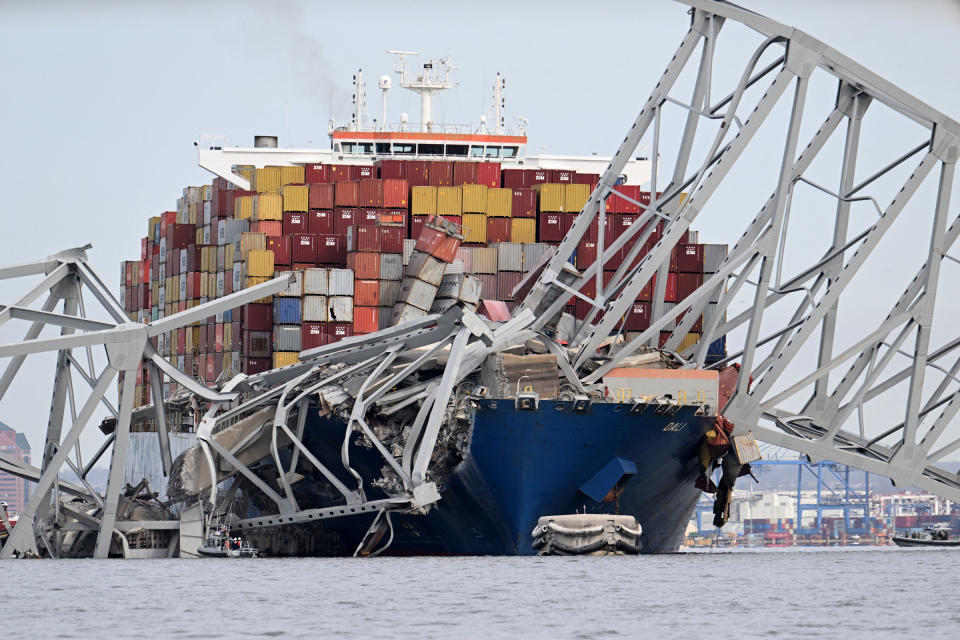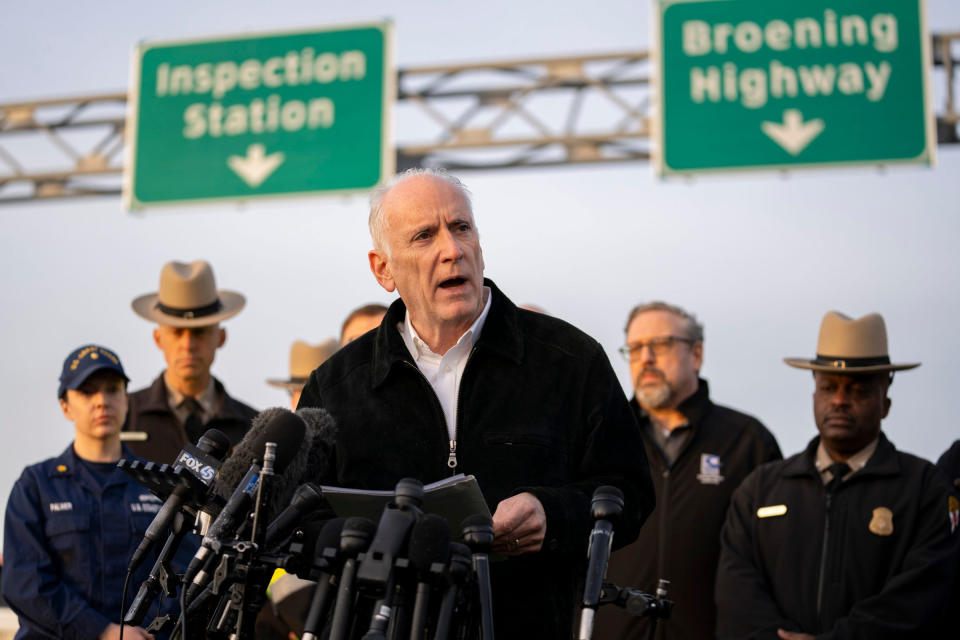6 Construction Workers Presumed Dead. Baltimore Bridge Collapse: What to Know
Six remaining missing people after a large cargo ship crashed into the Francis Scott Key Bridge in Baltimore on Tuesday morning were presumed dead by authorities by evening after rescue efforts found only two of the people who fell into the water.
All six unaccounted for victims were identified as construction workers who were on the bridge when it collapsed, the Baltimore Banner reported. At least two were Guatemalan nationals, the country’s foreign ministry said.
“Based on the length of time that we’ve gone in the search, the extensive search efforts that we put into it, the water temperature, that at this point, we do not believe that we’re going to find any of these individuals still alive,” U.S. Coast Guard Rear Admiral Shannon Gilreath said in a press conference around 7:30 p.m. local time.
Maryland Secretary of State Police Col. Roland Butler said at the same press conference that authorities have since transitioned away from search and rescue operations to recovery operations. Surface ships have been deployed overnight with divers set to be deployed at 6:00 a.m. Wednesday to “begin a more detailed search to do our very best to recover those six missing people.”
James Wallace, chief of Baltimore’s fire department, said in a press conference that “upwards of seven individuals” fell into the water after the Dali shipping container vessel crashed into the Francis Scott Key Bridge at 1:30 a.m. local time. The director of communications for Baltimore’s fire department, Kevin Cartwright, called it a “developing mass casualty event.”
During an earlier press conference, Baltimore Mayor Brandon Scott described the event as “an unthinkable tragedy.” He added: “We have to first and foremost pray for all of those who are impacted, those families, and pray for our first responders and thank them.”
Maryland Gov. Wes Moore said Tuesday that he’s authorized the deployment “everything from air, land, and sea resources” to ensure the search and rescue operation is “carried out to its fullest intent.” He also noted that there’s “a long road” ahead as the city rebuilds.
“The path to normalcy will not be easy,” said United States Secretary of Transportation Pete Buttigieg during a separate Tuesday press conference. “It will not be quick. It will not be inexpensive, but we will rebuild together in order to make sure that happens.”
He noted that federal agencies are working to address roadway concerns and supply chain impacts. “In many ways, our work is just beginning.”
Here’s what to know about the incident.
What happened?
The Singapore-flagged 948 ft. Dali vessel crashed into a column supporting the Francis Scott Key Bridge at around 1:30 a.m. local time in Baltimore, causing part of the bridge to collapse and catch fire before sinking.
At around 1:40 a.m., the Baltimore City Fire Department received an emergency services call to respond to a water rescue in the Patapsco River, according to fire chief Wallace.
Moore said in a press conference at 10:00 AM EST that preliminary investigations haven’t found “any credible evidence of a terrorist attack.” Baltimore Police said there was no evidence that the collision was intentional.
The ship’s crew issued a “mayday” call shortly before the crash that allowed authorities to stop vehicles from going on the bridge.

“We’re thankful that between the ‘mayday’ and collapse … that we had officials who were able to begin [to] stop the flow of traffic so more cars were not up on the bridge,” Moore said.
Several vehicles were on the bridge at the time of impact. At least seven people are believed to have fallen in the water. The Synergy Marine Group, which manages the Dali, has confirmed that all crew members, including its two pilots, are accounted for and unharmed, Reuters reported.
At least 10 commercial ships en route to Baltimore port dropped anchors nearby in the wake of the collision, according to Reuters, which cited tracking and maritime analytics provider MarineTraffic. All lanes remain closed in both directions on I-695 Key Bridge following the incident.
What does the video show?
Footage of the crash was originally shared by Streamtime Live but has since been widely reshared on social media platforms.
BREAKING: Ship collides with Francis Scott Key Bridge in Baltimore, causing it to collapse pic.twitter.com/OcOrSjOCRn
— BNO News (@BNONews) March 26, 2024
The clip shows fragments of the bridge falling into the Patapsco River, with some parts half submerged in the water and half emerging from it. Vehicles can also be seen falling from the structure.
Longer footage shared on social media showed what appeared to be losses of power on the freighter before it rammed into the bridge.
Recovery operations
Moore issued a statement Tuesday morning declaring a state of emergency and said he is working with an interagency team to deploy resources from the Biden Administration. “We are thankful for the brave men and women who are carrying out efforts to rescue those involved and pray for everyone’s safety,” Moore said.
“The U.S. Coast Guard is conducting search and rescue for those who remain unaccounted for as a result of the bridge collapse,” the White House said in a statement. “Senior White House officials are in touch with the governor and mayor to offer any federal assistance they need.”
Sonar and infrared technology, as well as underwater unmanned aerial vehicles (UAVs), have been deployed for search and rescue operations. Wallace, the Baltimore fire chief, added that the tides and darkness of the early hours had slowed rescue efforts down.
Few personal details are known about the two who were rescued so far. “One individual refused service and refused transport, essentially that person was not injured,” Wallace said. “However, there was another individual, that’s been transported to a local trauma center, that is in a very serious condition.”

President Joe Biden addressed the collapse at the White House on Tuesday afternoon, saying that, though the search and rescue operation is the highest priority at the moment, the federal government will support the city of Baltimore for “as long as it takes” to recover.
“It’s my intention that the federal government will pay for the entire cost of reconstructing that bridge,” Biden said. “I expect the Congress to support my effort.”
What do we know about the Francis Scott Key Bridge?
Opened in 1977, the Francis Scott Key bridge is named after the writer of The Star-Spangled Banner. In 1814, Francis Scott Key wrote the national anthem upon witnessing the British defeat in the Battle of Baltimore.
The bridge—which cost an estimated $110 million to build—is the outermost of three toll crossings on Baltimore’s Harbor. The four-lane bridge is 1.6 miles long and crosses over the Patapsco River.
The bridge carries over 11 million vehicles per year and 35,000 commuters per day, and is pivotal for East Coast shipping.
“This is no ordinary bridge,” Buttigieg said. “This is one of the cathedrals of American infrastructure. It has been part of the skyline of this region for longer than many of us have been alive.”
What do we know about the vessel?
The Dali vessel, which was chartered by shipping company Maersk, was headed for Colombo, Sri Lanka, and carrying cargo from the company. The vessel sustained damage, a fire department official told CNBC. The cause of the crash has yet to be determined by the firm.
The vessel was previously involved in a 2016 collision in Antwerp, Belgium, according to VesselFinder. While there were no casualties from the 2016 incident, the vessel’s bow scraped the quay and damaged parts of the hull.
National Transportation Safety Board Chair Jennifer Homendy said Tuesday afternoon the agency is “standing back” to allow search and rescue to take place, but has a team of experts in nautical operations, human performance, and engineering ready to investigate the ship’s operations and safety records to better understand what caused the crash.
Dali is owned by Singapore-based Grace Ocean Private Ltd. and managed by Synergy Marine Group. Synergy Marine Group, in a statement published Wednesday, confirmed the safety of their crew and offered their sympathies to victims of the tragedy. “Our thoughts are with them as we coordinate closely with the authorities to manage the incident’s aftermath, including environmental impact assessments.”
What have experts said?
“The first thing that springs to my mind is: was there a sudden fault with the ship’s engines or the steering gear? The other, of course, is: was there a navigational error?” David McFarlane, director of Maritime Risk and Safety Consultants Ltd, told Sky News.
He said that a one-person human error appears to be a less likely cause due to the number of staff on duty that could take over in an emergency. “The most likely cause of this is a failure in machinery or steering gear, but we just won’t know until the authorities have been on board,” McFarlane added.
Toby Mottram, Emeritus Professor at the University of Warwick and Structural Engineer, said in an analysis shared by the University of Warwick, that the moment of impact would have been intensified by the momentum of such a massive cargo vessel which was carrying goods.
“Despite meeting regulatory design and safety standards of the 1970s, the Baltimore Key Bridge may not have been equipped to handle the scale of ship movements seen today. However, modern navigation technologies should have prevented the ship from striking the pier,” Mottram said.
—Chad de Guzman in Singapore contributed reporting.
Correction, March 26
The original version of this story misstated the year when Francis Scott Key wrote “The Star-Spangled Banner.” It was 1814, not 1914.
Write to Armani Syed at armani.syed@time.com and Simmone Shah at simmone.shah@time.com.


